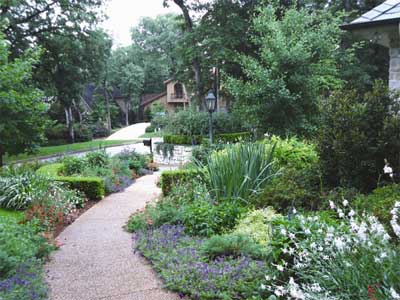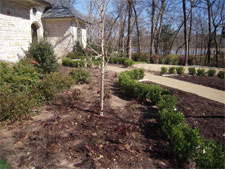From the Magazine – January, 2013

This garden, shown bursting with perennials at their peak, was previously a garden undergoing a winter facelift! (See the picture below.) All photos by Sharon Lee Smith.
Give Your Garden a Facelift
This is the time to rework beds and borders
Most gardens need a facelift every five to eight years. If your landscape is not making you smile, it’s time to re-think and re-work your beds.
A garden is never static. Perennials spread out of bounds and begin to crowd their neighbors. As shrubs mature, they often exceed the suggested size on the original plant label. Trees grow and cast more shade. Sometimes you are just tired of looking at the same plants.
There are some simple steps to take in analyzing just what changes might benefit your landscape. I find that taking digital pictures of the garden helps. Put the images up on your computer screen and have a good look. If it were someone else’s garden, would you be impressed? Something about seeing it from this perspective allows you to notice the imperfections.
To narrow the issues, ask yourself the following questions about your beds:
1. Are all the plants getting the proper amount of sunlight? Do they look thin? Are they leaning toward the light?
2. Do the plants have the proper amount of space to make them look natural?
3. Are tall plants located toward the back and shorter ones along the border? Perennials shift over time and change position in the garden, dramatically changing the original design.
4. Are the basic bones of the garden intact? It may be time to evaluate the permanent plants that provide structure year-round.
5. Are the borders of the garden defined? A well-defined edge delineates the space and can add needed structure.
Once you have analyzed the situation and decided what design changes would benefit the overall picture, it’s time to begin. Start with the garden ceiling. If more sunlight is needed, thinning the trees or judiciously removing lower limbs to make a higher canopy may help.
Shrubs that have grossly exceeded their space definitely need to be removed. Shrubs are “permanent,” but in Texas with our extended growing season, they can quickly outgrow their space. Hard pruning of shrubs works for a time, but it can produce many a tortured look, with little foliage and lots of woody stems. Discarding shrubs is hard for many people to do. My husband cringes when I ask him to take the chain saw to healthy overgrown plants. But if we meant to keep them forever, we would have given them more space initially.
Dwarf shrubs may need just a bit of pruning. Most respond well and will become dense and lush. A shrub still in good shape, but in the wrong spot, can be transplanted. Look at it the same way you would changing the bedspread on your bed to give your room a fresh new look. The same is true in the garden. A little moving and tweaking can do wonders for the overall picture.
Fall, winter and early spring are the best times to tackle overgrown beds. Plants respond well to transplanting in the cooler months. Dig and move plants as quickly as possible for best results. Don’t leave them sitting around for days waiting for a new home. Cloudy days are always good for this type of work.
Pruning shrubs when transplanting will help them compensate for root loss and lessen transplant shock. When roots are disturbed, it is hard for the plant to support all the original foliage. I usually cut back about one-third of the foliage and then dig and move the plant. Remember to water by hand any new plants going into the ground. A thorough soaking at this time is crucial to success.
Perennials can grow into each other and become a mish-mash over the years. The easiest time to thin them out is when they are trimmed for the winter or emerging from dormancy in the spring. I enjoy sharing starts with friends, transplanting those I need, and feeling no guilt when I toss out the extras. They will quickly fill back in. It can be a bit daunting to look at a bed of overgrown perennials and think about tackling the task. It’s actually easier than you think, and perennials are tough. Once into the project, the reward is immediate as the bed becomes less chaotic.
It is never too early to start the process. It is easier to tweak a little as you go along than to wait until it becomes a huge production. If you are at the huge production point, don’t be afraid. Remove the problem plants first. Plot your course of action, and get those beds back into shape.
About the author: Sharon Lee Smith is co-owner of Blue Moon Gardens, a retail nursery and garden center in Chandler (www.bluemoongardens.com).


